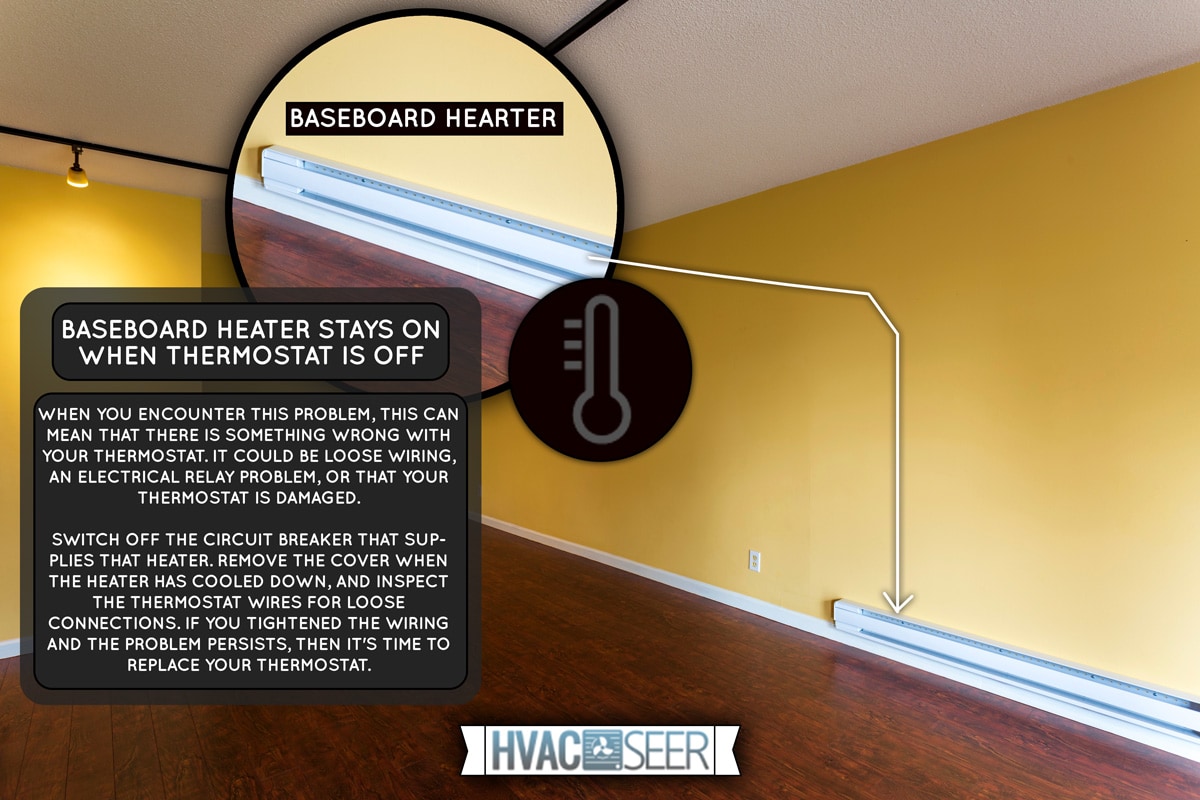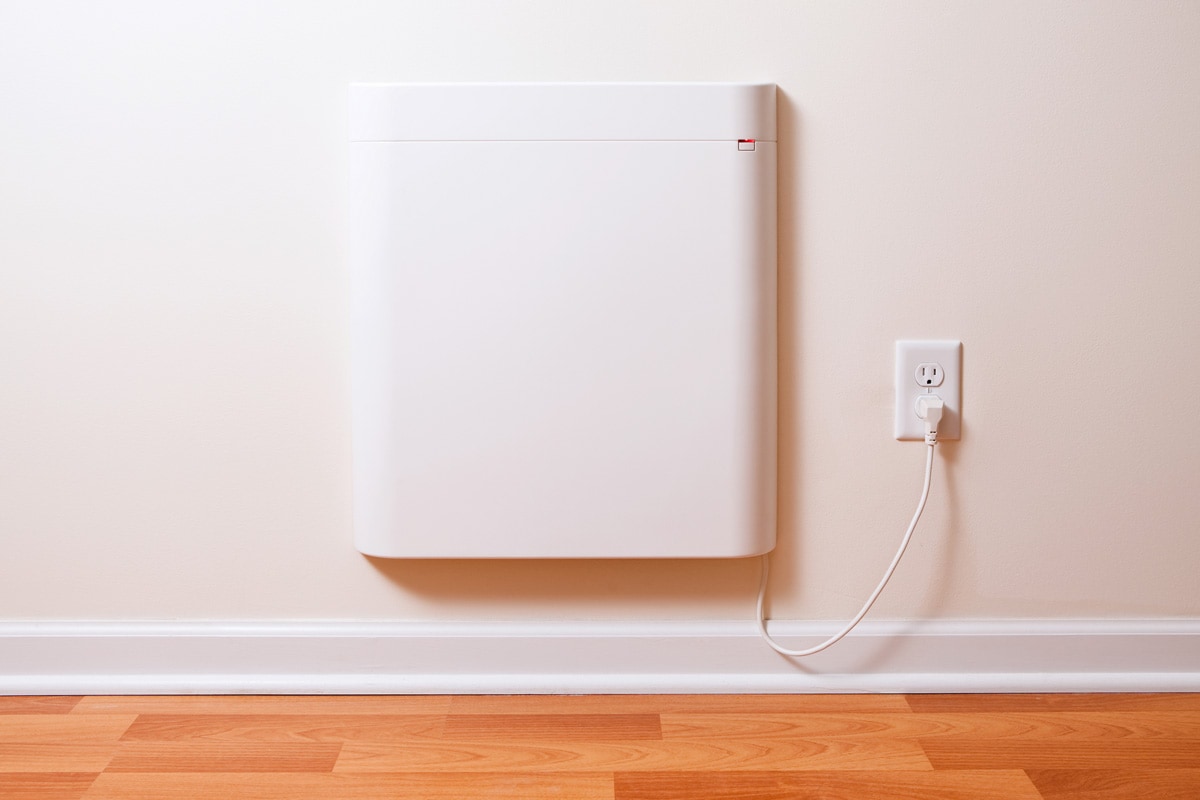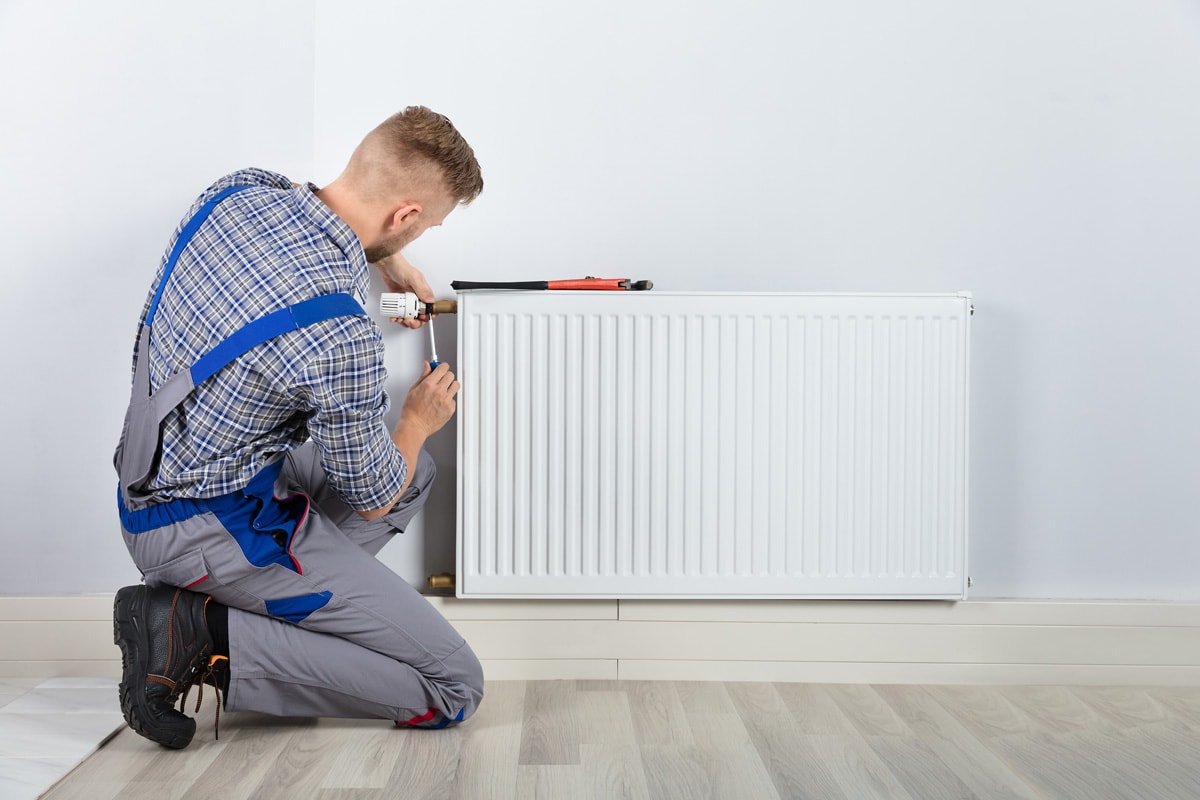Baseboard heaters provide you control over the temperature in any room of your home and are incredibly energy efficient. When you try to switch off your baseboard heater and nothing happens, it might be rather unsettling. So, what causes this? We did the research to bring you the answer.
When you encounter this problem, this can mean that there is something wrong with your thermostat. It could be loose wiring, an electrical relay problem, or that your thermostat is damaged.
Switch off the circuit breaker that supplies that heater. Remove the cover when the heater has cooled down, and inspect the thermostat wires for loose connections. If you tightened the wiring and the problem persists, then it's time to replace your thermostat.
Continue reading as we give you a simple guide on how to replace a broken thermostat. We'll also discuss other common problems you might experience with your baseboard heater and how to fix them. We'll also cover what things to watch out for when you use an electric baseboard heater.

What Are The Signs That You Have A Malfunctioning Thermostat?

Your baseboard heater won't switch off most of the time because the thermostat is broken. There are numerous additional indicators that the thermostat is the issue, including:
The Room Temperature Is Different From The Thermostat Set Temperature
This is the most common sign that there may be an issue with your thermostat. When you observe this happening, check your thermostat immediately so you'll know if you should replace it.
Low Battery Notification
Keep an eye out to see whether you could have missed a low battery warning. If there is a problem or the battery is running low, some "smart" thermostats can send you a direct message.
If not, check the thermostat's battery level to prevent a situation where you can't turn the baseboard heater off.
Higher Energy Bill Cost
Before the baseboard heater won't turn off, high energy bills and faulty thermostat readings may be the first indication of a problem.
If you see those symptoms, think about changing the thermostat before your energy costs continue to climb.
How To Replace A Baseboard Heater Thermostat?
To replace a thermostat, you can follow these steps:
1. Remove The Screws Off Your Old Thermostat
A cover plate and screws hold your old broken thermostat in place.
- Unfasten the screws holding the cover plate to the wall using a screwdriver. Take off the cover plate and put it aside for the time being.
- Through the use of mounting screws, the thermostat is fastened to the wall. The mounting screws must be unscrewed before you may carefully pull the thermostat away from the wall.
- After you remove the thermostat, there ought to be several exposed wires coming from the thermostat base.
2. Make The Wires Ready
This step is essential because you need to remember which wire goes where.
- Give each cable a letter, and take note of it so that you can quickly rewire them to the new thermostat.
- To keep track of the wires in case they fall through the wall, affix something to them, like tape or string.
- You can take out the thermostat base that is still fastened to the wall once you're done arranging the cables.
- Because different thermostats have varied installation requirements, pay special attention to the manufacturer's specific instructions.
3. Mount The New Thermostat To The Wall
- Run the low voltage cables you prepared through the new base plate before installing the thermostat. There will be clear apertures for the wires although each thermostat base plate is unique.
- Numerous thermostat bases contain wire-slot labels that correspond to wire colors. For the connections to line up, connect each wire to the appropriate color.
4. Replace The Thermostat Cover And Finish It Off
- To cover the thermostat, you must now attach the faceplate. Faceplates serve as a cover and attach directly to thermostats.
- Use drywall anchors if you're having difficulty securing the thermostat faceplate.
- To complete it, group all of the remaining wires together and, if possible, gently tuck them back into the wall.
- Do not leave any terminals exposed or loose if you are not using them.
Can A Damaged Check Valve Cause A Baseboard Heater To Not Turn Off?
The most frequent reason for baseboard heaters to remain on is faulty thermostats, but it can also be due to a broken check valve. One-way port valves called check valves are necessary for hot water heating systems.
Your baseboard heater will not switch off if you have a broken, unreliable, or old check valve.
To fix or replace a faulty check valve, you can do the following:
- Turn off the water supply, and use the drain plug to empty the water heater.
- Remove the hose connected to the check valve.
- Turn the old check valve off.
- Replace the old check valve with the new one by screwing it in.
- Test it out after reattaching the hose and turning on the water.
What Are The Things You Should Watch Out For When Using A Baseboard Heater?

If you're considering this heating option, you should be aware of the limitations and issues with baseboard heaters.
Proper Airflow
Cool air is drawn via the bottom of an electric baseboard heater, and warm air is released from the top.
To ensure sufficient airflow throughout the system, they are made to sit a half inch above the floor or carpet. The heaters should not be blocked by furniture or the vent system in any way.
Heating Element
A heating element is attached to a group of metal fins within an electric baseboard heater, which heats the air surrounding them before releasing the warm air into the room.
The fans are susceptible to becoming covered and clogged with dust and debris over time because of the continual airflow. The heating efficiency can also be impacted by the thin metal fins' ease of breakage and bending.
Empty, Unused Rooms
Baseboard heaters have the benefit of allowing you to set the specific heat in each area separately.
However, homeowners frequently try to cut costs by shutting off heaters and isolating some areas. This is not recommended because it could result in frozen pipes in the walls or floors or cold air leaking into other rooms, making other heaters work harder.
It is advisable to lower the heat in empty rooms to around 122 degrees Fahrenheit to increase efficiency.
Thermostats
A thermostat is typically included with electric baseboard heaters. However, they are not necessarily the greatest at maintaining a constant temperature.
Additionally, because the heaters require a particular voltage to be constantly flowing through them, wall-mounted thermostats for central heating systems should not control them.
The finest results come from having a professional install the proper wall-mounted control thermostats for baseboard heaters.
Click here for this product on Amazon.
Home Insulation
In a house heated by baseboard heat, sufficient insulation is crucial. With insufficient insulation, the heaters must operate harder and longer, which increases their inefficiency and costs while also increasing the heat demand and wear and tear.
It is more difficult to stop drafts and air leaks when using baseboard heaters because they don't blow air through vents as a furnace does.
You can improve the efficiency with very easy measures like adding insulation, weatherstripping to doors and windows, and caulking to make spaces more airtight.
What Are Other Problems You Might Encounter With Your Baseboard Heater?

Here are some common baseboard heater issues you might face and what to do with them:
The Baseboard Heater Won't Turn On

When this happens, you can do the following to diagnose the problem:
- The first thing to do when your heater won't turn on is to raise the thermostat. Some appliances have built-in thermostats; if yours does, the thermostat may have had a problem in the past and a wall thermostat may have been installed to operate the appliance instead.
- If so, turn both the built-in and the wall thermostats up to the maximum setting until the appliance turns on.
- If that doesn't work, check the main electrical panel for any circuit breakers that may have tripped, and reset them if you find any.
If you try these steps and still can't get the heater to turn on, one of the thermostats or the heater's wiring is probably faulty.
A homeowner with some DIY electrical know-how to identify the issue may disassemble the heater or thermostat, but this task usually needs an electrician or HVAC technician.
The Circuit Breaker Often Trips
It may be necessary to fix a short circuit in the wiring if the circuit breaker controlling the heater trips when it is reset or shortly after.
There are a few things you can do on your own before hiring an electrician:
Unplug The Heater
If you have a plug-in heater, you might want to try unplugging it and resetting the breaker. If the breaker doesn't trip, the circuit is overloaded, and the heater needs to be installed on a new circuit. Or, you need to remove other loads from the circuit.
Check Breaker Rating
If the heater is hardwired to a specific circuit, look at the breaker rating and compare it with the heater's current draw, which you can find on a label attached to the heater.
The breaker rating must not be less than the heater's current draw. If it is, you need to install a higher-rated circuit breaker.
Final Words
It can be a thermostat problem or a broken check valve that's causing your baseboard heater to stay on even when the thermostat is off. You can fix this problem by simply replacing the thermostat or the check valve.
If you want to learn more about baseboard heaters, you can check out these related articles:

